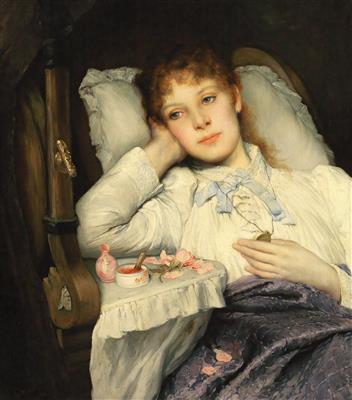Gabriel Cornelius Ritter von Max

(Prague 1840–1915 Munich)
“Traviata”, titled, signed G. v. Max, oil on canvas, 83.5 x 66.5 cm, framed, (Rei)
Provenance:
C. J. Wawra, Vienna, 17 November 1913, lot 84;
Private Collection Vienna.
Catalogued in:
Friedrich von Boetticher, Malerwerke des 19. Jahrhunderts, Hofheim am Taunus 1979, vol. I, 2, p. 996, no. 152
The plot of Giuseppe Verdi’s opera ‘La Traviata’ is based on Alexandre Dumas’ novel ‘La dame aux camélias’. At the centre is the courtesan Violetta Valéry, with whom the young Alfredo Germont falls in love. As an invitation to a rendezvous she gives him a camellia, which he should bring back to her as soon as it has withered. This is how the relationship between the young man and the courtesan unfolds. His sincere character finally convinces Violetta that true, genuine love is indeed possible, but Alfredo’s father urges her to end the relationship so as not to harm Alfredo’s reputation and that of his family. Since Violetta is suffering from tuberculosis and knows that she will not live much longer, she agrees to the separation to protect Alfredo. To make it easier for him to leave, she intentionally lets him believe that she has parted ways with him in order to return to her old life as a courtesan. Alfredo is deeply hurt and turns away from her in public.
The present lot shows Violetta probably at the beginning of the third act, after the separation from Alfredo. Her health has deteriorated significantly, and she is constrained to the bed. The objects on the bedside table seem to symbolically emphasise her situation: the withered rose indicates her own withering, the rouge crucible is reminiscent of the fact that she has for too long painted her sickly pale cheeks with artificial freshness. Her fingers play with a medallion around her neck – foreshadowing of the end of the opera. After Alfredo learns from his father that he had forced Violetta to part with him, he returns to her with repentance. They dream once again of a happy future together, but Violetta’s illness has already progressed too far. As a farewell she gives Alfredo her medallion with her picture. After her death, he should try to be happy and find someone else. He should give her this medallion and Violetta will pray for them both in heaven. With that, Violetta gets up from her bed one last time before collapsing and dying in Alfredo’s arms.
Expert: Mag. Dimitra Reimüller
 Mag. Dimitra Reimüller
Mag. Dimitra Reimüller
+43-1-515 60-355
19c.paintings@dorotheum.at
29.04.2019 - 17:00
- Dosažená cena: **
-
EUR 62.800,-
- Odhadní cena:
-
EUR 15.000,- do EUR 20.000,-
Gabriel Cornelius Ritter von Max
(Prague 1840–1915 Munich)
“Traviata”, titled, signed G. v. Max, oil on canvas, 83.5 x 66.5 cm, framed, (Rei)
Provenance:
C. J. Wawra, Vienna, 17 November 1913, lot 84;
Private Collection Vienna.
Catalogued in:
Friedrich von Boetticher, Malerwerke des 19. Jahrhunderts, Hofheim am Taunus 1979, vol. I, 2, p. 996, no. 152
The plot of Giuseppe Verdi’s opera ‘La Traviata’ is based on Alexandre Dumas’ novel ‘La dame aux camélias’. At the centre is the courtesan Violetta Valéry, with whom the young Alfredo Germont falls in love. As an invitation to a rendezvous she gives him a camellia, which he should bring back to her as soon as it has withered. This is how the relationship between the young man and the courtesan unfolds. His sincere character finally convinces Violetta that true, genuine love is indeed possible, but Alfredo’s father urges her to end the relationship so as not to harm Alfredo’s reputation and that of his family. Since Violetta is suffering from tuberculosis and knows that she will not live much longer, she agrees to the separation to protect Alfredo. To make it easier for him to leave, she intentionally lets him believe that she has parted ways with him in order to return to her old life as a courtesan. Alfredo is deeply hurt and turns away from her in public.
The present lot shows Violetta probably at the beginning of the third act, after the separation from Alfredo. Her health has deteriorated significantly, and she is constrained to the bed. The objects on the bedside table seem to symbolically emphasise her situation: the withered rose indicates her own withering, the rouge crucible is reminiscent of the fact that she has for too long painted her sickly pale cheeks with artificial freshness. Her fingers play with a medallion around her neck – foreshadowing of the end of the opera. After Alfredo learns from his father that he had forced Violetta to part with him, he returns to her with repentance. They dream once again of a happy future together, but Violetta’s illness has already progressed too far. As a farewell she gives Alfredo her medallion with her picture. After her death, he should try to be happy and find someone else. He should give her this medallion and Violetta will pray for them both in heaven. With that, Violetta gets up from her bed one last time before collapsing and dying in Alfredo’s arms.
Expert: Mag. Dimitra Reimüller
 Mag. Dimitra Reimüller
Mag. Dimitra Reimüller
+43-1-515 60-355
19c.paintings@dorotheum.at
|
Horká linka kupujících
Po-Pá: 10.00 - 17.00
kundendienst@dorotheum.at +43 1 515 60 200 |
| Aukce: | Obrazy 19. století |
| Typ aukce: | Salónní aukce |
| Datum: | 29.04.2019 - 17:00 |
| Místo konání aukce: | Wien | Palais Dorotheum |
| Prohlídka: | 20.04. - 29.04.2019 |
** Kupní cena vč. poplatku kupujícího a DPH
Není již možné podávat příkazy ke koupi přes internet. Aukce se právě připravuje resp. byla již uskutečněna.
Všechny objekty umělce
